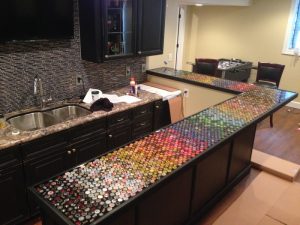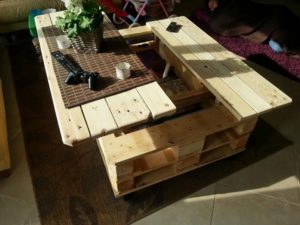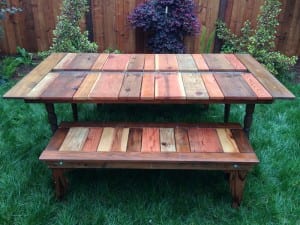Last Updated on July 16, 2024 by teamobn
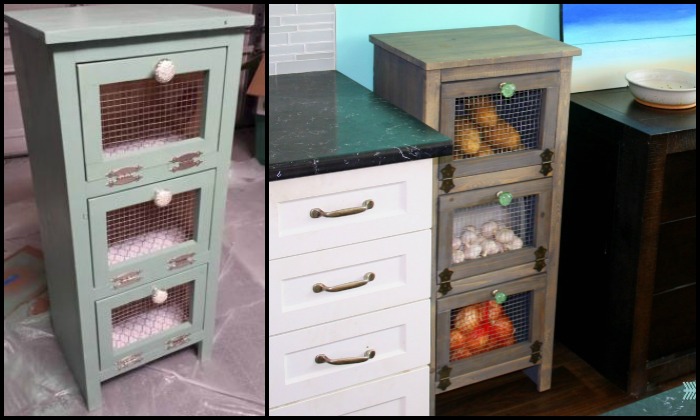
Vegetables are an important part of a healthy diet. They are a good source of vitamins and minerals, and they can help you feel full. Eating a variety of vegetables every day is important for good health. Vegetables provide essential vitamins and minerals, and they are a low-calorie, low-fat food. Including vegetables in your diet can help you reach and maintain a healthy weight, and it can also reduce your risk of chronic diseases such as heart disease, stroke, and type 2 diabetes.
Why is it important to have a great vegetable big cupboard? There are many reasons why having a great vegetable storage bin is important. Proper storage can help extend the shelf life of your vegetables, which means you can enjoy them for longer. It can also help keep your vegetables fresh and crisp, so you can enjoy their flavour and nutrition.
Additionally, having a good storage system for your vegetables can help you stay organized and reduce food waste. When your vegetables are properly stored, you can easily see what you have on hand and can plan your meals accordingly. This can help you save money and reduce your overall food footprint.
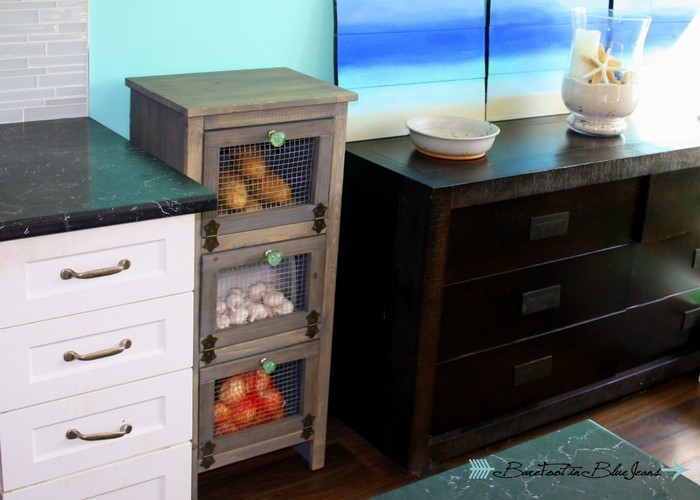
If you’re looking for more ideas on how to store vegetables, then take a look at this nice and simple vegetable bin cupboard. This is a great way to keep your vegetables organized and tidy, and it’s also a great way to save space in your kitchen. This bin cupboard is also perfect for those who want to have more than one type of vegetable in their kitchen.
This easy DIY vegetable bin storage project can be completed in just one or two days, depending on how much time you need for staining and painting. The end result is a stylish and functional storage solution for your kitchen that will help keep your vegetables fresh and organized. This project requires only basic carpentry skills and materials, making it a great option for beginners.
This vegetable bin cupboard has a functional design, not too space-consuming yet provides a lot of room in each compartment. Perfect for when you are in need of additional storage in the kitchen!
This vegetable bin cupboard storage unit is versatile and can be used for a variety of purposes, not just for storing vegetables. It’s perfect for organizing your space and keeping things tidy. You can use it to store other items such as clothes, linens, or even non-perishable food items.
Contents
Building a Vegetable Bin Cupboard
Click on any image to start the lightbox display. Use your Esc key to close the lightbox.![]()
Materials
- 12′ long 1×12 Timber
- 8′ long 1×2 Timber
- 4′ of 4-1/4″ tall Base Moulding
- 1/4 sheet of 1/4″ Plywood (or Beadboard or other backing material)
- Chicken Wire/Wire Mesh
- 3 sets of Surface Mount Hinges
- 3 Clasps
- 3 Knobs or Handles
- 1-1/4″ Pocket Hole Screws
- 1-1/4″ and 1″ Finish Nails
Tools
- Measuring Tape
- Speed Square
- Pencil
- Kreg Jig
- Drill
- Circular saw
- Miter Saw
- Brad Nailer
- Staple Gun
- Safety Gear
Instructions
Step 1: Design and Planning
- Measure the space where you plan to place the vegetable bin cupboard to determine the best size for your needs. Sketch the design including dimensions for each part.
Step 2: Cutting the Timber
- Use the circular saw or miter saw to cut the 1×12 timber into pieces for the sides, top, bottom, and shelves of the cupboard. Refer to your design for specific dimensions.
- Cut the 1×2 timber for the frame support and door frames.
Step 3: Assembling the Frame
- Assemble the frame of the cupboard using the 1×12 pieces. Drill pocket holes with the Kreg Jig and join the pieces using the 1-1/4″ pocket hole screws.
- Ensure the frame is square by checking the diagonal measurements with the speed square.
Step 4: Adding the Shelves
- Insert the shelves at desired intervals inside the frame. Secure them with pocket screws or finish nails.
Step 5: Attaching the Backing
- Cut the plywood or beadboard to size for the back of the cupboard.
- Attach it to the frame using the brad nailer with 1″ finish nails.
Step 6: Building the Doors
- Construct the doors using the 1×2 timber for the frames. Measure and cut the timber to fit the front openings.
- Attach chicken wire or wire mesh to the frame using the staple gun, then secure the frame pieces around the mesh with nails or screws.
Step 7: Mounting the Doors
- Attach the doors to the cupboard frame using the surface mount hinges.
- Install clasps on the doors for secure closing.
Step 8: Attaching the Moulding and Handles
- Cut the base moulding to size and attach it to the bottom of the cupboard using the brad nailer.
- Screw the knobs or handles onto the doors for easy opening.
Step 9: Finishing Touches
- Fill any visible screw holes with wood filler and sand the cupboard for a smooth finish.
- Paint or stain the cupboard as desired. Allow it to dry completely.
Step 10: Final Setup
- Place your new vegetable bin cupboard in its designated spot.
- Organize your vegetables inside the bins.
This vegetable bin storage can be put indoors or outdoors, making it a versatile storage option for your home. The bin is made of durable materials that will withstand the elements, whether you’re using it inside or out. The bin features a spacious interior that is perfect for storing all of your fresh produce. The bin can also have a handle for easy carrying.
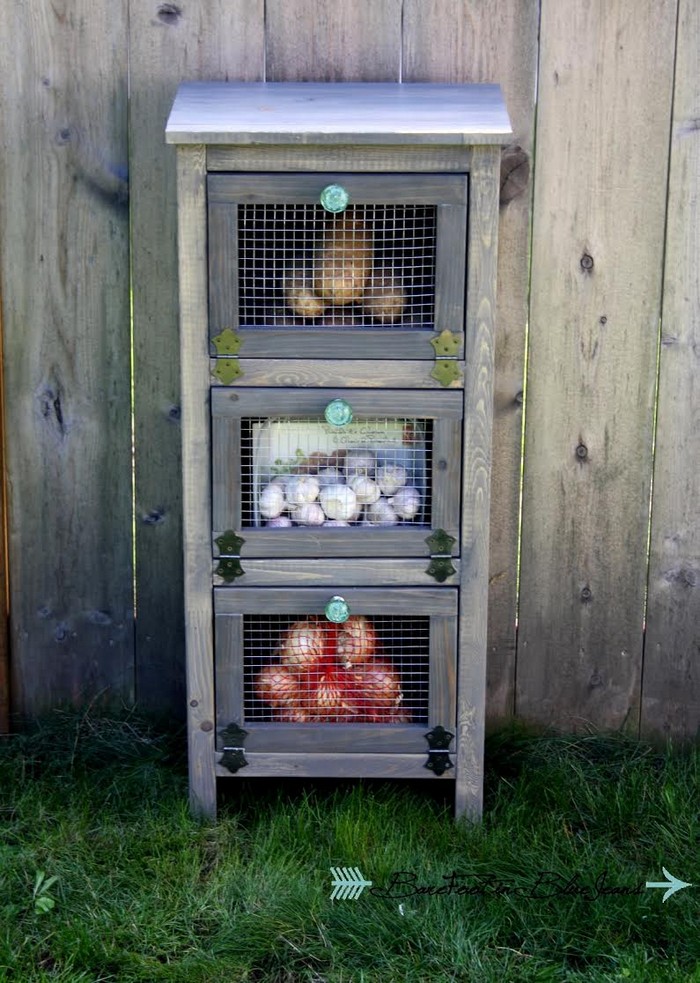
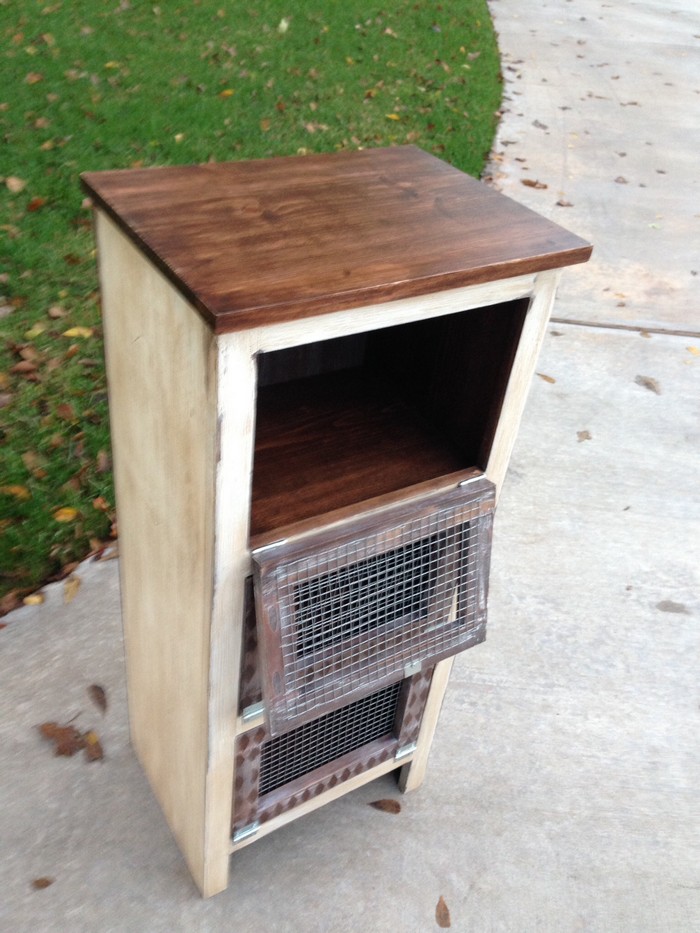
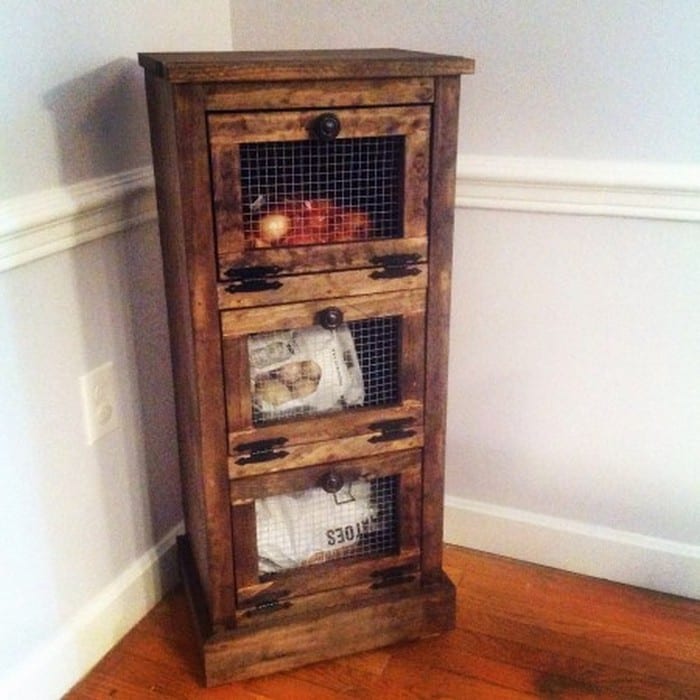
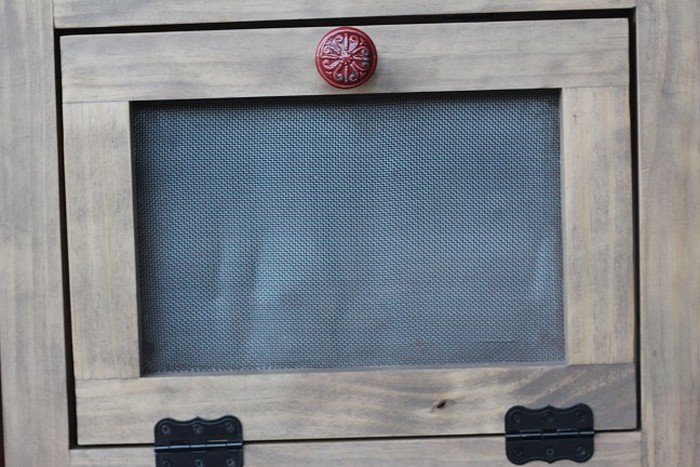

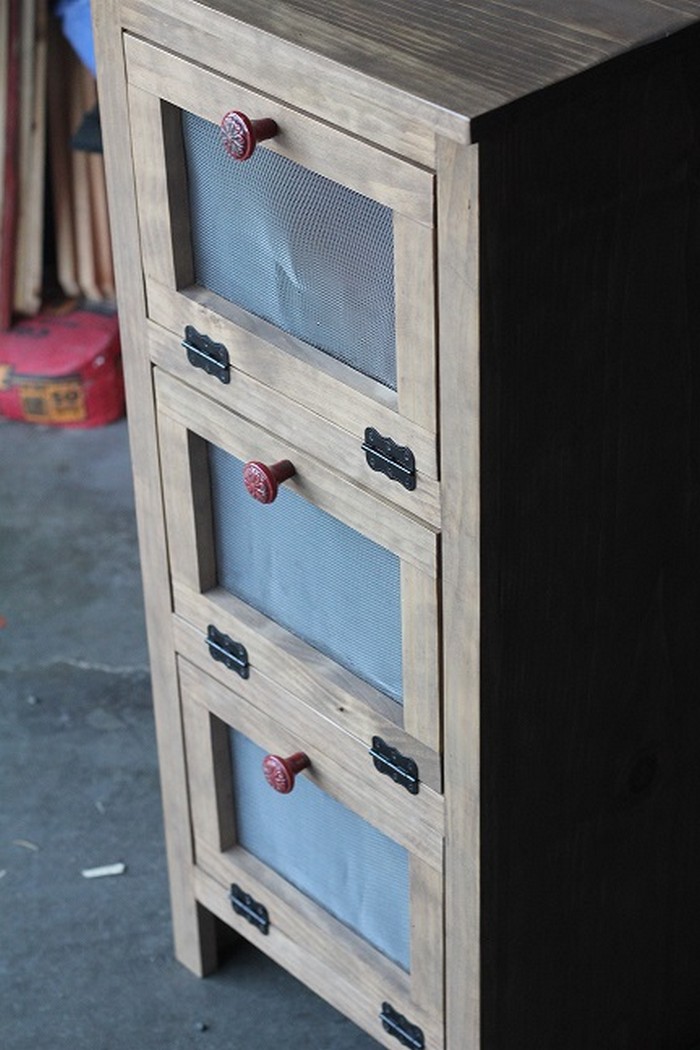
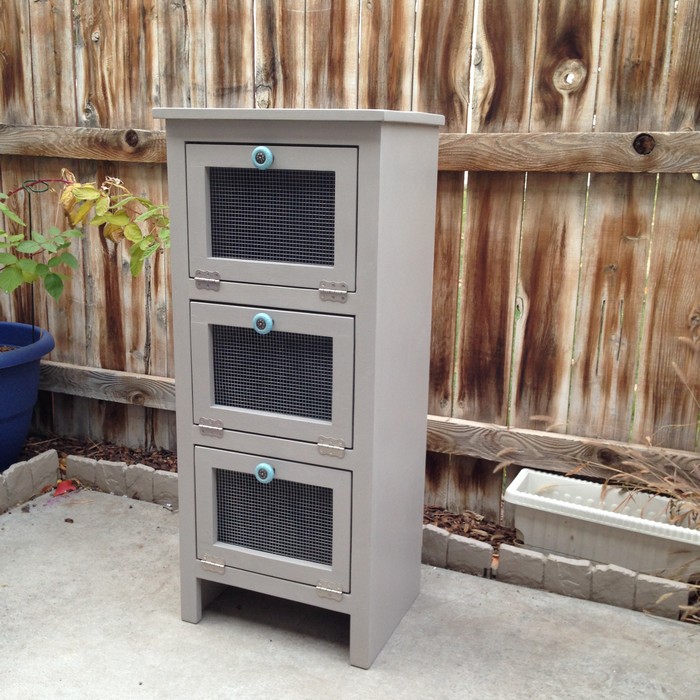
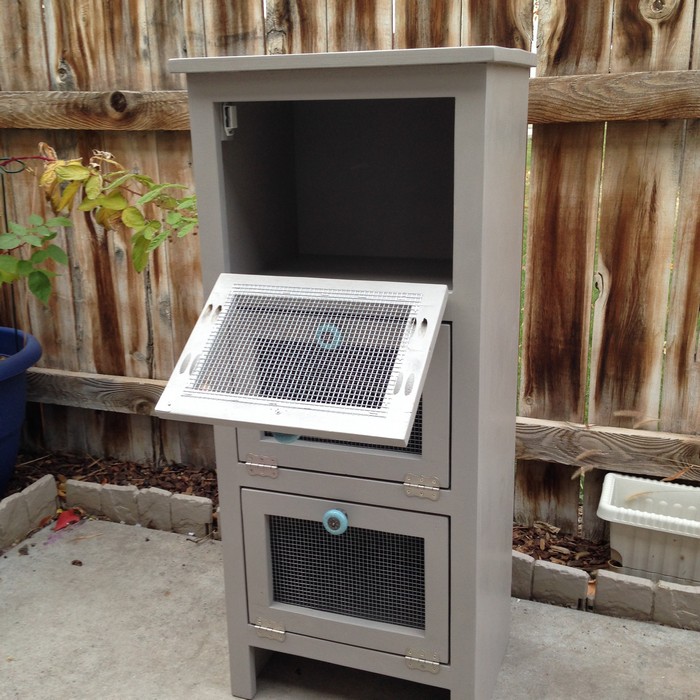
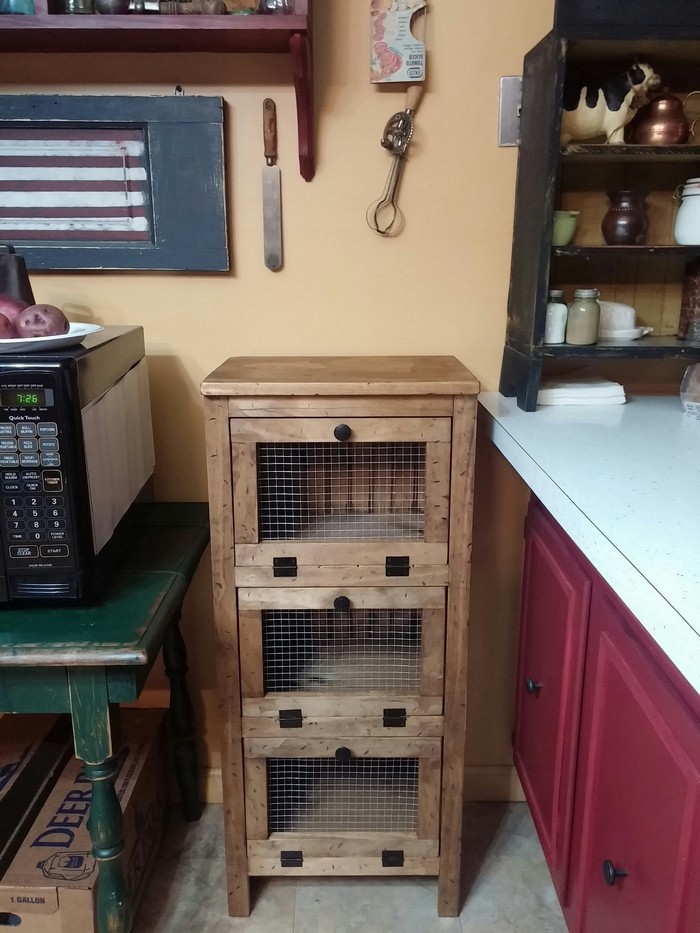
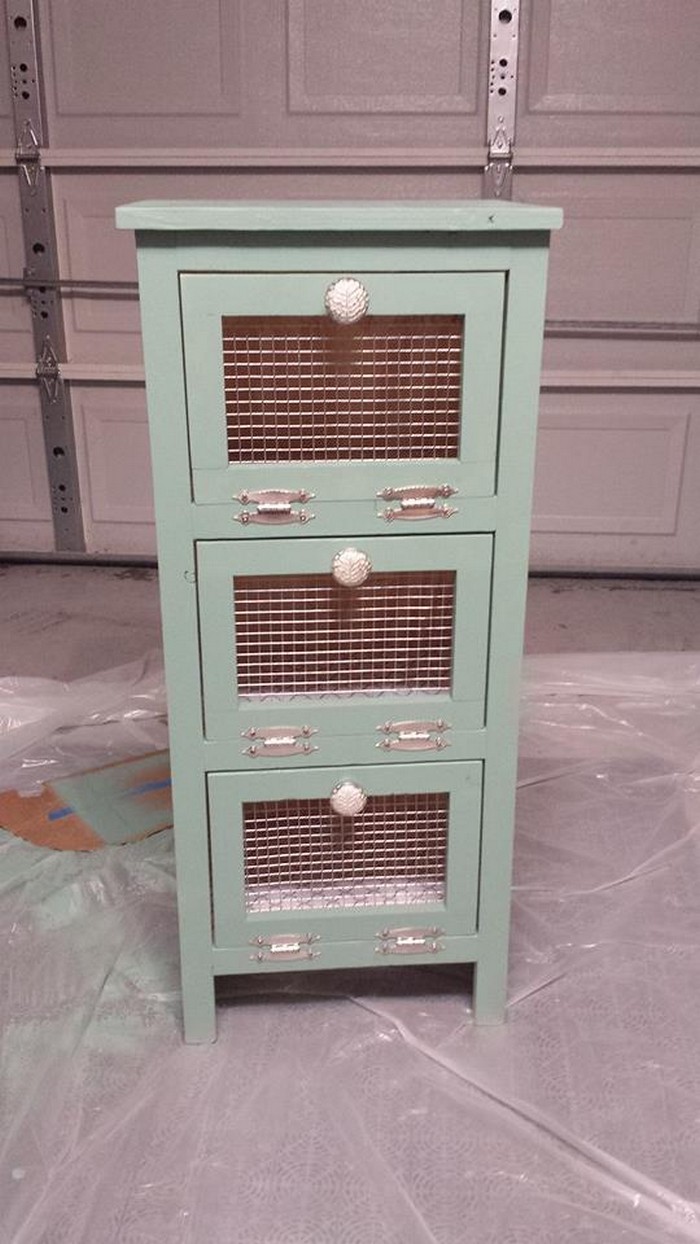
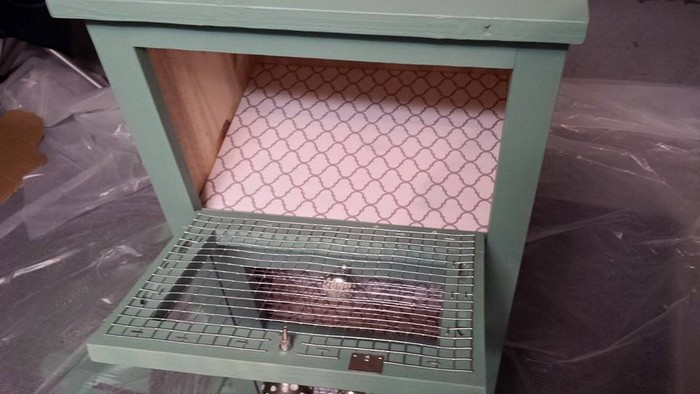

Well, what do you think? If you want one, you can get more step-by-step instructions from Ana White over here…
Smart Storage Solutions with Vegetable Bin Cupboards
Organizing your kitchen can dramatically enhance both its appearance and functionality. A vegetable bin cupboard is a versatile addition that not only stores your produce but also helps declutter your space. Here, we explore several smart storage solutions that utilize the convenience and efficiency of a vegetable bin cupboard.
Optimal Placement in the Kitchen
Strategically placing your vegetable bin cupboard can make a significant difference in your kitchen’s workflow. Ideally, position it near the food preparation area for easy access while cooking. This minimizes the time spent moving around the kitchen and increases efficiency during meal prep.
Utilize Vertical Space
To maximize the utility of a vegetable bin cupboard in smaller kitchens, consider designing it to utilize vertical space. Tall, slim cupboards can store a surprising amount of produce without taking up much floor space. This approach not only saves space but also makes the cupboard a focal point in your kitchen décor.
Adjustable Compartments
Customizable compartments within your vegetable bin cupboard can help organize different types of produce according to size and type. Adjustable shelves or dividers allow you to modify the storage space as needed, accommodating everything from bulky root vegetables to delicate herbs.
Integration with Other Storage
Integrating your vegetable bin cupboard with other storage elements in the kitchen can streamline your storage strategy. For example, incorporating pull-out drawers at the base or spice racks on the inside of the cupboard doors enhances functionality. This integration ensures all essentials are within reach, making cooking and storage more efficient.
Tech-Enhanced Features
Modernizing your vegetable bin cupboard with technology can transform how you store produce. Installing humidity and temperature controls can help keep your vegetables fresh for longer. Additionally, smart sensors can alert you when produce is nearing the end of its freshness, reducing waste and ensuring you enjoy the best quality food.
These smart storage solutions make a vegetable bin cupboard an indispensable part of any kitchen, blending functionality with innovative design to keep your produce fresh and your kitchen organized.
The Role of Ventilation in Vegetable Storage
Proper ventilation is crucial for extending the shelf life of vegetables stored at home. A vegetable bin cupboard, when designed with good airflow, can significantly enhance the quality and longevity of your produce. This segment explores why ventilation is vital and how it can be effectively integrated into your vegetable bin cupboard.
Importance of Airflow
Vegetables continue to respire after being harvested, which means they consume oxygen and release carbon dioxide and moisture. Without adequate ventilation, this moisture can accumulate within the storage area, promoting the growth of mold and bacteria. Effective airflow ensures that these gases and moisture are exchanged with fresh air, keeping the produce dry and reducing the risk of spoilage.
Designing for Ventilation
Incorporating ventilation into your vegetable bin cupboard is not just about having a few holes in the structure. Strategic design involves creating a consistent flow of air that can move freely around each piece of produce. Here are a few design tips:
- Mesh or Perforated Doors: Using doors made with chicken wire, mesh, or perforated materials allows air to circulate freely, even when the cupboard is closed.
- Ventilation Slots: Including multiple small ventilation slots on the sides or back of the cupboard helps maintain a continuous airflow, crucial for keeping the storage environment fresh.
Placement Matters
The location of your vegetable bin cupboard within your kitchen can also impact its ventilation. Avoid placing the cupboard next to heat-producing appliances like ovens or dishwashers, as this can alter the temperature and humidity levels around your produce. Instead, choose a cooler, darker spot to ensure vegetables remain fresh for as long as possible.
Regular Maintenance
Maintaining the ventilation features of your vegetable bin cupboard is essential. Regularly check and clean any vents or mesh to remove dust and debris that could block airflow. This maintenance ensures that the cupboard continues to provide the best possible environment for storing vegetables.
By understanding and implementing proper ventilation techniques in your vegetable bin cupboard, you can significantly enhance the freshness and shelf life of your stored produce. Effective airflow not only preserves the quality of vegetables but also contributes to a more sustainable and waste-conscious kitchen.
Conclusion
Building a vegetable bin cupboard offers a practical solution for keeping your kitchen organized and your produce fresh. With proper design considerations like adequate ventilation and smart storage features, this DIY project enhances both the functionality and aesthetics of your cooking space. Embrace the benefits of a custom-made vegetable bin cupboard to make the most of your kitchen’s potential.



